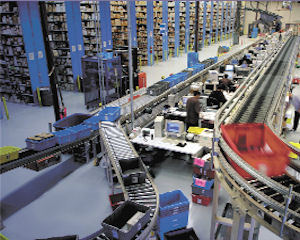Wesco Aircraft Holdings Inc. is the latest company in the greater San Fernando Valley region to go public. The Valencia-based company, one of the world’s largest aircraft parts distributors, raised about $315 million in its initial public offering on July 28. The proceeds went to CEO Randy J. Snyder and the company’s main investor, The Carlyle Group. The Valley region has seen its share of IPO activity since last year, which some market observers say may help to boost the region’s business profile. Earlier this year, seed maker Ceres Inc. registered for a $100 million IPO, which is scheduled for later this year. Ceres, based in Thousand Oaks, creates seeds to grow biomass feedstock to convert into biofuel. Last year, Inphi Corp., with major operations in Westlake Village, and online marketing firm ReachLocal went public. Mark Sogomian, Ernst & Young’s IPO leader for the West Coast, said the long-term benefits of IPO activity in the region can be significant, particularly when a new public company stays headquartered in Southern California and continues to grow. “There is also an indirect impact in that an active IPO market sends a message of increased confidence in the economy, which has an impact on the larger business community,” Sogomian said. California is leading the nation in the number of companies making an IPO, according to the second-quarter 2011 Ernst & Young LLP US IPO Pipeline study, released earlier this month. From April through the end of June, 42 U.S. companies went public and 140 others were intending to go public, with an average deal valued at $169 million. Out of the companies registered for an IPO, California had 25, followed by Texas with 14 and Florida with nine, the study showed. In the Ernst & Young report, technology was the most active industry sector. Other active sectors include oil and gas, banking and finance and industrial products. A strong IPO market, industry insiders said, makes it easier for a company to raise capital and reduces the likelihood that a company will become an acquisition or merger target. “From an economic standpoint, an IPO is great for job growth and successful IPO companies stay independent and support jobs,” Sogomian said. Nancy Sidhu, the senior economist with the Los Angeles County Economic Development Corp., said the increasing number of Southern California companies selling shares indicates a certain dynamic taking place in the region. “It says we have new companies, young companies that are just going public and willing to submit to more scrutiny,” she said. Wesco IPO For Wesco investor Carlyle, going public was the next logical step after investing in the company for five years, said Hal Weinstein, executive vice president of sales and marketing. “This is part of their long term exit strategy that will take some years, admittedly,” Weinstein said. A private investment firm often has the goal of taking their investment public as a way to make back their investment, said Ben Kuo, editor and publisher of SoCalTech.com, an online tech industry publication. “They build a company into something the public will find valuable and an IPO is a way to get it out there,” Kuo said. It is not unusual that private shareholders sell off part of their stake in a company to other investors in an IPO. A secondary offering is one in which shares are sold to raise capital. Wesco employees, including top executives, now are shareholders in the company, Weinstein said. Wesco provides inventory management services and distributes parts to the prime contractors and their subcontractors for making commercial and military aircraft. The company had a 10 percent share of the $6.5 billion global market for hardware, bearings, electronic components and machined parts in 2010, according to its prospectus for investors. Shares in the company were sold at $15 on July 28 and have traded in $14.25 to $15.25 range since. Carlyle remains a majority investor in the company. With the proceeds not going to the company itself, the IPO is not likely to make a big difference in the near term on the company’s financial position, Sidhu said. But the fact the company is now listed on an exchange facilitates the next time it wants to add shares, she said. For the aerospace industry, the Wesco stock sale sends a signal that the company is ready to be more competitive and where it wants to position itself in the market, Weinstein said. The company’s growth area, Weinstein said, is in the supply chain management side and delivery of parts to aircraft manufacturers and subcontractors. “We will be a significant player,” Weinstein said. “Even bigger than we’ve been.” Fifty-three percent of the company’s business is in military aircraft and the balance in commercial planes. The commercial sector is the bright spot, as there is a production rate increase of 30 percent to 40 percent forecast for Boeing Co. and Airbus, two of the world’s premier commercial jet makers, said Ken Herbert, an analyst with Wedbush Securities, who follows the aerospace industry. “This is the start of a cycle of a strong recovery in terms of build rates,” Herbert said. Wesco’s plans for growth includes getting new business from existing customers through supply chain management services, adding new customers that competitors cannot serve, and serving airlines and airline maintenance organizations, making acquisitions, and entering high growth markets such as Mexico, China, India and Saudi Arabia. Adding employees or expanding facilities in Valencia is not in the company’s plans as of now, Weinstein said. “We are in good shape here for the moment,” Weinstein said.
